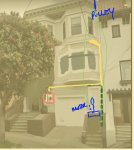modern insulated conductors that don't even require pull lube. You would be much better off using a reduced insulated neutral than a full sized bare neutral.
I question if the load is really as high as you calculated it to be for a home in SF but there is no way the unbalanced neutral load will be anywhere near the full calculated load. Care to share your load calc's with us?
Anothing I noticed is it appears the bottom meter is much lower than PG&E's minimum 48". Did they approve it being lower?
I was just thinking the same about the SimPull
he wants to get rid of all gas appliances, get a heat pump and at least one EV
But that is an interesting Idea, to use the calculated load for the unbalanced current.
Especially since the big loads are all 240v!
Kind of like a high leg delta w all three phase
The residential loads are maybe 60a per unit, max
the big loads in the one unit are all 240
heat pump, cooking, oven, ev, water heat, etc etc
Curt you are a smart man thank you
now i have to look for the code ref on using calculated load for the service entrance conductors
the reason I was so interested in stripping the neutral, was because inspector recommended it to me at startwork walkthru









